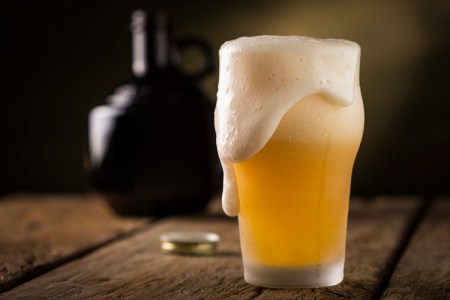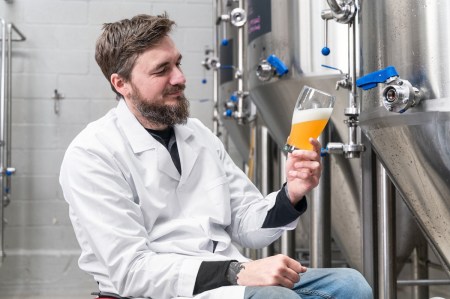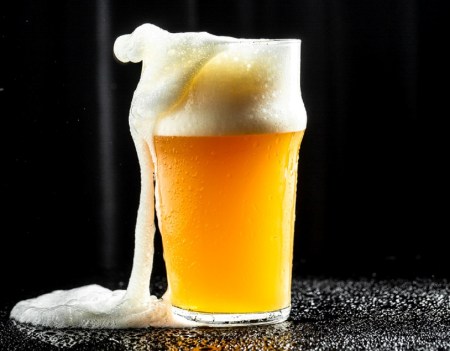
Everyone is in love with haze these days, but I remember when it was to be avoided and many papers were presented by esteemed brewing scientists, such as Karl Siebert, that helped us understand what beer haze was, and how to prevent it. And now we are inviting it to the table. Well, well, well, how turns have timed…
Beer haze is a protein-polyphenol complex that forms via hydrogen and hydrophobic bonding, which are weaker forms of molecular bonding between less-polar substances. There are two types of beer haze: chill haze (temporary) and colloidal haze (permanent).
Chill haze is primarily hydrophobic bonding, whereas colloidal haze is primarily hydrogen bonding. Covalent bonding, a stronger bond, is also said to play a role in permanent haze, but I don’t know the extent – it’s probably small but significant, like approximately 10 per cent.
Anyway, the haze is formed from malt proteins, malt polyphenols and hop polyphenols (polyphenols are basically small, immature tannins.) The haze forms when the polyphenols form molecular bridges between the small proteins. The type and molecular size of the protein determines whether it is haze active.
Haze active proteins come from the hordein in barley and gliadin in wheat and they are rich in the amino acid proline, which is the bonding site for the polyphenols.
I guess I should explain that a “protein” is a polymeric mass of hundreds of amino acids and peptides and that these haze-active proteins are generally small enough to be beer soluble. It’s when lots of them link up with lots of polyphenol bridging molecules that they get large enough to be visible as haze. Eventually these polymeric haze blobs get big enough that they become permanent haze and then as the beer ages, and oxidation staling reactions occur, these hazes cross-link into tannins, which eventually become large enough to be subject to gravity and they settle out.

Promoting stability
In fact, there is a bell-curve or size distribution effect of the size of proteins that can best form a stable haze. If the proteins are too small, they will still bond with polyphenols but are still too small to create visible haze. Relatively mid-size proteins are the right size to create a visible haze and larger proteins readily form haze but are much more likely to polymerise with other haze particles and settle out, which is the common fate of most hazy IPAs after a month or two.
So, the secret to a stable haze in hazy IPA is having more of the smaller haze-active proteins in the wort/beer, because they have a longer haze “life” than the larger haze-active proteins.
Thus, the question becomes how do we promote more of these smaller haze active proteins?
Here is where we enlist the help of higher protein adjuncts, such as flaked wheat and flaked oats. Interestingly, oats have higher protein levels than wheat (typically 16% v 13%), but wheat has a much higher level of the proline rich proteins (80% v 10%). Therefore, if you are in search of stable haze, wheat is better than oats.
Secondly, a paper by Delvaux, Combes, and Delvaux (MBAA TQ 41 (1), 2004) demonstrated in trials that malted wheat produced a more stable haze than unmalted wheat and also demonstrated that the modification level (ie. Kolbach Index) of both the barley and wheat malts affected both the degree and stability of the haze. Essentially, more modification (eg. KI of 45 v 40%) results in more of the smaller haze active proteins and a more stable haze. Less modification (~40%) may result in larger peptides and deeper haze initially but drops out sooner.
The important point here is not the specific KI numbers, but the concept. Every batch of malt and subsequent mash is going to be slightly different despite having similar KI numbers to this example.
I want you to understand the tradeoffs: unmalted wheat and oats will give higher initial haze, but it will drop out quicker. Malted wheat is going to create less haze but it will be a longer lasting haze.
These concepts are born out by my friends at El Segundo Brewing in El Segundo, California where their best results, they say, come from using 50 per cent of the base malt as malted wheat, and adding five to 10 per cent of flaked wheat. This gives them a better spectrum of protein sizes they feel, and a more stable beer in package.

John Palmer’s Morning Glory Hazy recipe
OG: 1.062
FG: 1.016
ABV: 5.8%
IBU: 60
Volume: 20 litres
Ingredients
3kg Pale ale malt
2kg Wheat malt
250g Flaked wheat
250g Flaked oats
125g Rice hulls
150g Galaxy hop pellets
150g Belma hop pellets
140g Riwaka hop pellets
Mangrove Jacks M66 Ale yeast
Recommended water profile
Ca 75-125, Mg 10-20, Total Alk 0, SO4 150-250, Cl 100-150, RA –100-0
Method
- Mash in to hit 65°C for 60 minutes.
- Sparge and transfer to kettle with 23 litres of wort at 1.052.
- Bring to the boil for 60 minutes.
- Flame out and add 75g Galaxy, 75g Belma and 70g Riwaka to steep for 20 minutes.
- Cool wort to 18 °C and run into fermenter.
- Oxygenate or aerate and pitch yeast and maintain 18°C during fermentation.
- On day 3 or 4, dry hop with 75g Galaxy, 75g Belma, and 70g Riwaka.
- When FG stabilises, keg or bottle as usual.

John Palmer is the author of the bestselling home brew book How to Brew. In every issue of Beer & Brewer magazine he does a deep dive into a particular facet of brewing better beer and regularly provides one of his recipes. Subscribe to our magazine here.

